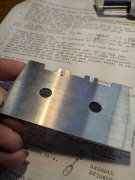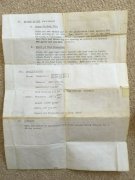Got the gauge measured.
The plate is slightly undersized, and the 38.1 mm long feeler gauges slightly oversized in thickness, perfect length.
Stacked for use, they're approximately .001 mm oversized, if I use averaged plate thickness. But this will slightly vary across the plate.
Looks like they're aware of the tolerances and matching the pieces, or perhaps just luck.
The plate is nonmagnetic stainless, the feelers are aluminum.
Definitely not commercial/industrial quality, but it'll work very well for what I'm doing.
The plate is slightly undersized, and the 38.1 mm long feeler gauges slightly oversized in thickness, perfect length.
Stacked for use, they're approximately .001 mm oversized, if I use averaged plate thickness. But this will slightly vary across the plate.
Looks like they're aware of the tolerances and matching the pieces, or perhaps just luck.
The plate is nonmagnetic stainless, the feelers are aluminum.
Definitely not commercial/industrial quality, but it'll work very well for what I'm doing.
Attachments
Last edited:








